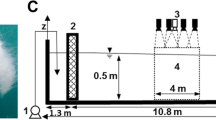Abstract
The unique morphology of the toes of the great crested grebe (Podiceps cristatus), which are asymmetrically lobed with a narrower skin flap on the lateral side of the toe, enables these birds to swim very efficiently. Here we study video recordings of a diving grebe and stroboscopic pictures of its moving feet and conclude that the bird uses a hydrodynamically lift-based foot (power) stroke to propel itself underwater, with the separated toes functioning as multiple slots to increase the lift-to-drag ratio. The asymmetric lobes are an adaptation for self-stabilization of the toes during the power stroke, and the toes themselves act as separate hydrofoils, each producing lift and each being twistable individually under hydrodynamic load.
This is a preview of subscription content, access via your institution
Access options
Subscribe to this journal
Receive 51 print issues and online access
$199.00 per year
only $3.90 per issue
Buy this article
- Purchase on Springer Link
- Instant access to full article PDF
Prices may be subject to local taxes which are calculated during checkout

Similar content being viewed by others
References
Webb, P. & Blake, R. W. in Functional Vertebrate Morphology (eds Hildebrand, M., Bramble, D. M., Liem, K. F. & Wake, D. B.) 110–128 (Harvard Univ. Press, Cambridge, MA, 1985).
Braun, J. & Reif, W.-E. N. Jb. Geol. Paläont. Abh. 169, 307–332 ( 1985).
Norberg, U. M. Vertebrate Flight (Springer, New York, 1990).
Hofton, A. New Sci. 146–147 (20 April 1978).
Norberg, R. Å. Biol. Rev. 48, 561–596 ( 1973).
Smith, A. M. O. J. Aircraft 12, 501–530 (1975).
Norberg, R. Å. in The Beginnings of Birds (eds Hecht, M. K., Ostrom, J. H., Viohl, G. & Wellnhofer, P.) (Proc. Int. Archaeopteryx Conf. Eichstätt, 1984, 1985).
Author information
Authors and Affiliations
Rights and permissions
About this article
Cite this article
Johansson, L., Lindhe Norberg, U. Asymmetric toes aid underwater swimming. Nature 407, 582–583 (2000). https://doi.org/10.1038/35036689
Issue Date:
DOI: https://doi.org/10.1038/35036689
This article is cited by
-
The hydrodynamic performance of duck feet for submerged swimming resembles oars rather than delta-wings
Scientific Reports (2023)
-
Developmental mechanisms underlying webbed foot morphological diversity in waterbirds
Scientific Reports (2020)
-
Delta-wing function of webbed feet gives hydrodynamic lift for swimming propulsion in birds
Nature (2003)
Comments
By submitting a comment you agree to abide by our Terms and Community Guidelines. If you find something abusive or that does not comply with our terms or guidelines please flag it as inappropriate.



